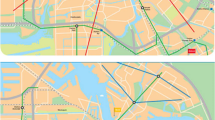Abstract
The black-box nature of Artificial Neural Network (ANN) based transportation models continues to evade their practical application despite their formidable prediction abilities. The purpose of this study is to address the 'black-box’ issue of ANN-based mode choice models utilizing SHapley Additive ExPlanations (SHAP). The SHAP approach is applied to an ANN-based mode choice model in order to explain the model's predictions and comprehend the impact of various variables on mode choice. The work also demonstrates how a detailed investigation of the Shapley explanations of misclassified examples can provide insights to improve the model. In addition, the effect of ANNs' lack of reproducibility on Shapley explanations is explored and reported. The study further demonstrates how transfer learning may be used to enhance model explanations for scenarios with fewer data points. The findings of this study indicate that SHAP can be useful for gaining meaningful insights into ANN-based models, encouraging their adoption in practice.







Similar content being viewed by others
Notes
This is not to be confused with the python package called Shapely which is used for manipulation and analysis of planar geometric objects.
References
Koushik ANP, Manoj M, Nezamuddin N (2020) Machine learning applications in activity-travel behaviour research: a review. Transp Rev 40:288–311. https://doi.org/10.1080/01441647.2019.1704307
Hagenauer J, Helbich M (2017) A comparative study of machine learning classifiers for modeling travel mode choice. Expert Syst Appl 78:273–282. https://doi.org/10.1016/j.eswa.2017.01.057
Taco PWG, Barreto GA, Kawamoto E (2007) Artificial neural networks applied for individual modeling of walking trip chaining patterns. In: Proceedings of 10th International Conference on Computers in Urban Planning and Urban Management, CUPUM 2007. pp 1–13
Arentze T, Timmermans HJP (2004) A learning-based transportation oriented simulation system. Transp Res Part B Methodol 38:613–633
Vanhulsel M, Janssens D, Wets G, Vanhoof K (2009) Simulation of sequential data: an enhanced reinforcement learning approach. Expert Syst Appl 36:8032–8039. https://doi.org/10.1016/j.eswa.2008.10.056
Drchal J, Čertický M, Jakob M (2019) Data-driven activity scheduler for agent-based mobility models. Transp Res Part C Emerg Technol 98:370–390. https://doi.org/10.1016/j.trc.2018.12.002
van Cranenburgh S, Wang S, Vij A et al (2022) Choice modelling in the age of machine learning—discussion paper. J Choice Model 42:1755–5345. https://doi.org/10.1016/J.JOCM.2021.100340
Wang S, Wang Q, Zhao J (2020) Deep neural networks for choice analysis: extracting complete economic information for interpretation. Transp Res Part C Emerg Technol 118:102701. https://doi.org/10.1016/j.trc.2020.102701
Alwosheel A, van Cranenburgh S, Chorus CG (2019) ‘Computer says no’ is not enough: using prototypical examples to diagnose artificial neural networks for discrete choice analysis. J Choice Model 33:100186. https://doi.org/10.1016/j.jocm.2019.100186
Alwosheel A, van Cranenburgh S, Chorus CG (2021) Why did you predict that? Towards explainable artificial neural networks for travel demand analysis. Transp Res Part C Emerg Technol 128:103143. https://doi.org/10.1016/J.TRC.2021.103143
Lundberg SM, Lee SI (2017) A unified approach to interpreting model predictions. In: Advances in neural information processing systems. Neural information processing systems foundation, pp 4766–4775
Centraal Bureau voor de Statistiek (CBS), Rijkswaterstaat (RWS-WVL) Onderzoek Onderweg in Nederland—ODiN 2019. DANS (2020). https://doi.org/10.17026/dans-xpv-mwpg
Pan SJ, Yang Q (2010) A survey on transfer learning. IEEE Trans Knowl Data Eng 22:1345–1359. https://doi.org/10.1109/TKDE.2009.191
Acknowledgements
The authors thank Centraal Bureau voor de Statistiek (CBS) and Rijkswaterstaat (RWS-WVL), Netherlands for granting permission to access the ODiN 2019 dataset which has been used in this study. The research presented in this paper is a part of the FIRP2019 project number MI02073G funded by the Industrial Research Development (IRD) unit, IIT Delhi. The authors thank IRD, IIT Delhi for this support.
Funding
The funding has been received from Industrial Research Development (IRD) unit, IIT, Delhi with Grant no. MI02073G.
Author information
Authors and Affiliations
Corresponding author
Ethics declarations
Conflict of interest
On behalf of all authors, the corresponding author states that there is no conflict of interest.
Additional information
Publisher's Note
Springer Nature remains neutral with regard to jurisdictional claims in published maps and institutional affiliations.
Rights and permissions
Springer Nature or its licensor (e.g. a society or other partner) holds exclusive rights to this article under a publishing agreement with the author(s) or other rightsholder(s); author self-archiving of the accepted manuscript version of this article is solely governed by the terms of such publishing agreement and applicable law.
About this article
Cite this article
Koushik, A., Manoj, M. & Nezamuddin, N. SHapley Additive exPlanations for Explaining Artificial Neural Network Based Mode Choice Models. Transp. in Dev. Econ. 10, 12 (2024). https://doi.org/10.1007/s40890-024-00200-6
Received:
Accepted:
Published:
DOI: https://doi.org/10.1007/s40890-024-00200-6




